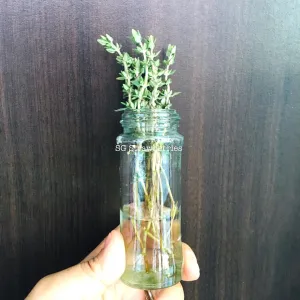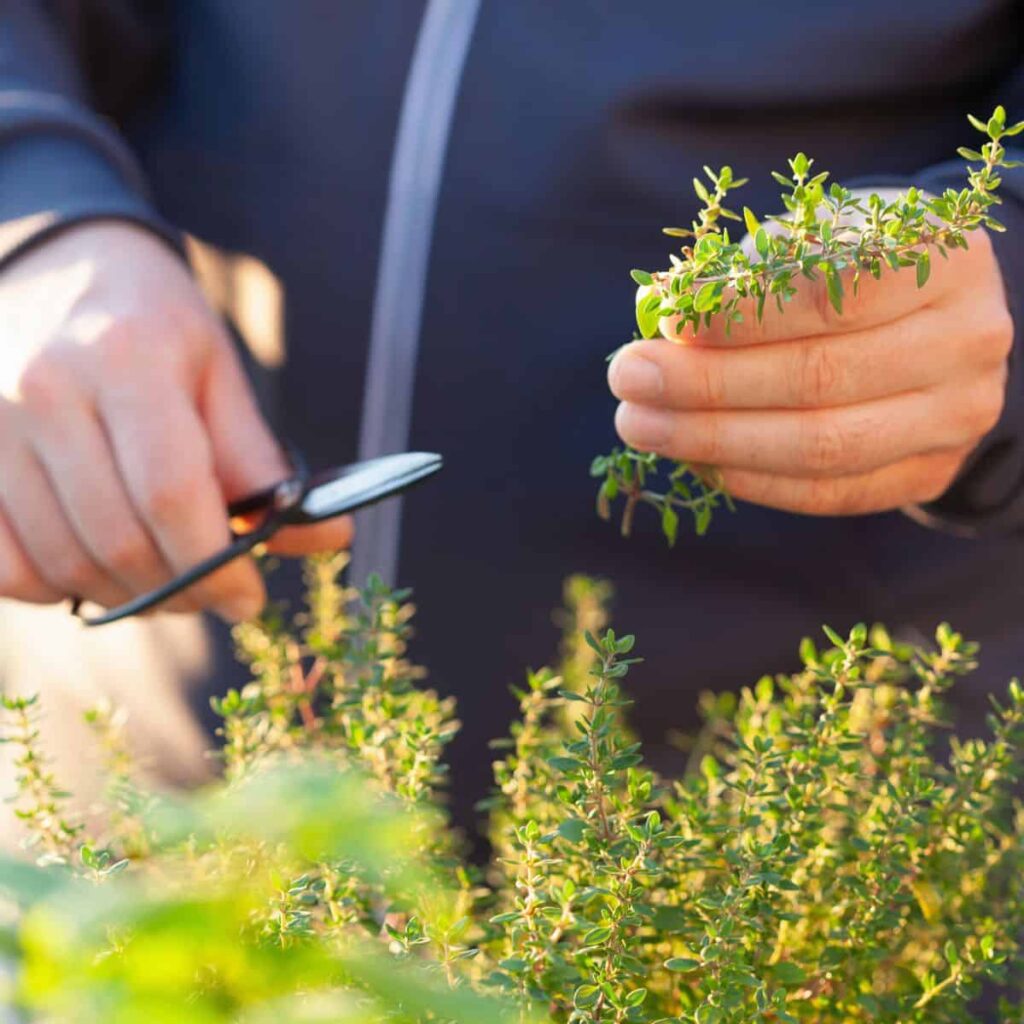
From its vibrant fragrance to its myriad health benefits, growing thyme in your garden is an enchanting journey that adds a touch of magic to your meals and nourishes your senses. In this article, you’ll learn all about growing thyme in your garden or house and why you should not shy away from it. As you probably heard already (just like Rosemary), thyme has a lot of benefits:
- It is great as seasoning for soups, sauces, and potatoes among other things
- Used as an ingredient in several home remedies
- Acts as a repellent for pest insects due to its scent
- Attracts pollinators
Whether you’re a total beginner looking to get your hands dirty, or an experienced gardener trying out something new, this article is for you!
About Thyme
Thyme is one of the many herbal plants found in popular cuisine. Plants have several long stems with numerous small leaves and the mature ones grow up 6 to 12 inches tall, depending on the variety.
Thyme is used in many Mediterranean and Italian dishes, including:
- Soups
- Potatoes
- Sauces
- Rice dishes
- Bread
- Lentils
- Tea
It has also been used traditionally for its medicinal properties and has been known to act as an anti-inflammatory, anti-oxidant, anti-bacterial, and antiseptic agent.
Some common varieties of thyme are:
- Common Thyme (thymus vulgaris): also known as French or English thyme, it has the classic smell that you expect.
- Lemon Thyme (thymus citriodorus): this variety has a true lemon scent.
- Creeping Thyme (thymus serpyllum): acts as a ground cover, only growing a few inches tall.
- Caraway Thyme (thymus herba-barona): thyme that has the smell of caraway.
Getting Started with Thyme Cultivation

Growing thyme from seed is not as common as through cuttings or through division. The seeds are picky and don’t always germinate well. If you’re new to growing thyme, I recommend buying pre-started plants from a nursery.
Being native to the Mediterranean, thyme likes soil with good drainage and does not like to be overwatered. It’s a drought-resistant plant and should only be watered once the soil has completely dried. In terms of pH, the soil should be slightly alkaline.
Light is also very important because full sun is ideal for thyme. They like it sunny for 6 to 8 hours per day throughout the growing season. Indirect light will not give the plant what it needs to grow, especially when growing indoors.
Planting and Propagation
Let’s take a look at how you can grow thyme from seeds, cuttings, and from division.
Growing Thyme from Seed:
- Fill a container with well-drained soil meant for starting seeds.
- Scatter a few seeds in a container and cover them with a light layer of soil.
- Water the seeds thoroughly and cover them with a piece of plastic wrap.
- Place the container on a sunny, warm windowsill.
- Wait for the seeds to germinate. They make take up to 12 weeks.
- Transplant the seeds once they’re a few inches tall.
Growing Thyme from Cuttings:

- Cut a stem off about 6 inches long using a sterile knife or a pair of pruning shears.
- Strip off the leaves from the bottom half.
- Dip the bottom half into the rooting hormone. (optional)
- Place the cutting into a container filled with potting soil. Make a hole with a pencil first so you don’t rub off the rooting hormone.
- In a few weeks, check if the cutting has formed roots by tugging gently on the stem. If it offers resistance then there are roots! Don’t tug any more than necessary.
- Once there are roots, you can transplant the cutting to a larger pot or into your garden.
Propagating Thyme from Division:
- Dig up the plant, being careful not to knock too much dirt out of the root ball.
- Separate one of the shoots from the main plant.
Replant the main plant back into the soil and plant your offshoot into a new container or spot in your garden.
Care and Maintenance
Thankfully, thyme is not a hard plant to care for, but there are some factors regarding the soil and watering that you definitely want to keep in mind. Let’s go through them!
- Allow the soil to dry out between waterings. Don’t water too often, since thyme is adapted to resisting droughts. Overwatering results in fungal infections such as root rot.
- An all-purpose fertilizer diluted to half-strength is good for thyme.
- Pruning is important if you haven’t harvested in a while. Cut about a third of the plant off halfway down and choose any older woody stems.
- Mulching is a good idea to keep the weeds down.
- Being an aromatic plant, thyme repels many common pests and insects. Pests like aphids and spider mites can be removed by washing them off the plant or by using insecticidal soap.
- If you have indoor thyme plants and you don’t have a sunny enough window, consider using grow lights.
Harvesting and Utilization

When harvesting thyme from new plants, don’t cut off more than a third of the plant. For larger, more well-established plants, you can harvest more.
- Snip off whatever you need for your recipe.
- Leave a few inches of stem on the plant.
- Strip the green leaves off – don’t add the stem to your food.
Advanced Techniques and Tips
- Thyme can be companion-planted with brassicas, beets, potatoes, tomatoes, and other herbs.
- Growing thyme indoors is a great way to reduce pests and control moisture. A pot 6 to 8 inches in diameter works great! Make sure your pot has holes in the bottom, especially if it’s a clay pot.
- Vertical installations are common with thyme. It can even be grown using hydroponics!
What could possibly go wrong?
- Root rot will cause the leaves to turn brown. You can uproot the plant, snip off any rotten roots, and then replant it.
- Excessive nitrogen in the soil may cause the leaves to turn yellow.
- Fungal infections on the leaves can result from watering the leaves. Always water the ground around the plant, especially on indoor plants.
- Aphids and spider mites can be removed by blasting them with water or by using insecticidal soap.
Conclusion
I hope you found this article useful and that you’ll try growing your own thyme! There’s nothing quite like the smell of fresh herbs and good food made with it. Best of luck and happy gardening!
Frequently Asked Questions
It’s native to the Mediterranean but it’s cultivated in much of the northern hemisphere. Thyme likes soil with good drainage and lots of sunlight, for about 6 to 8 hours per day throughout the growing season.
How Big Does Thyme Get?
Common thyme grows up to a foot tall. Creeping thyme covers an area up to a foot and a half long.
When Do I Plant Thyme?
Plant your thyme outside in late spring or early summer, after your last local frost date.
How Far Apart Do I Plant Thyme?
It really depends on variety, but in general, you should space your plants 12 to 18 inches apart.
Does Thyme Need Full Sun?
Yes, thyme likes full sun. If you have your plants growing indoors, consider using grow lights.

